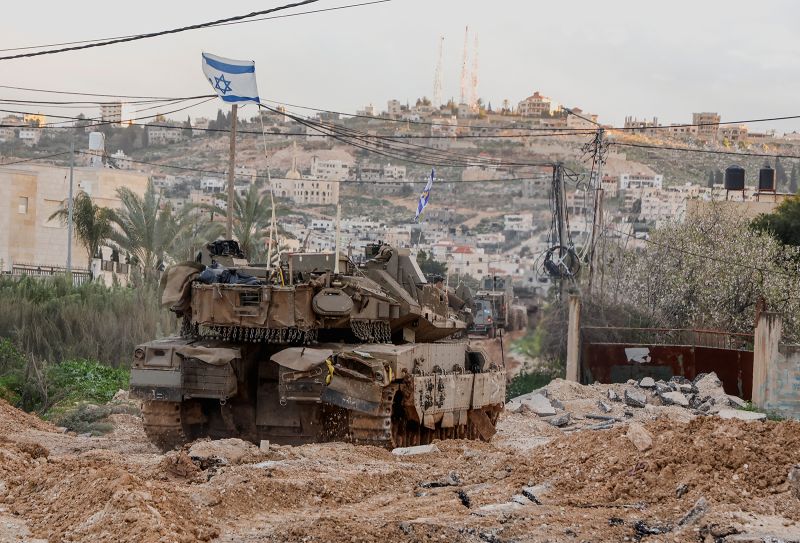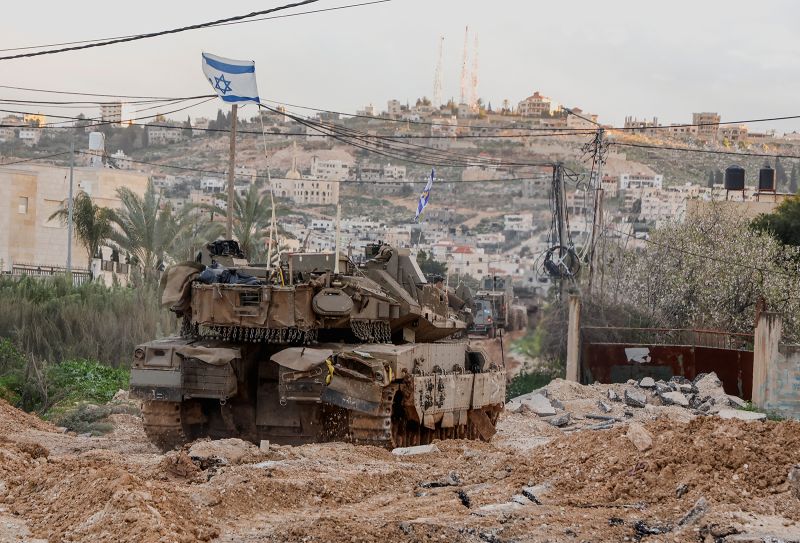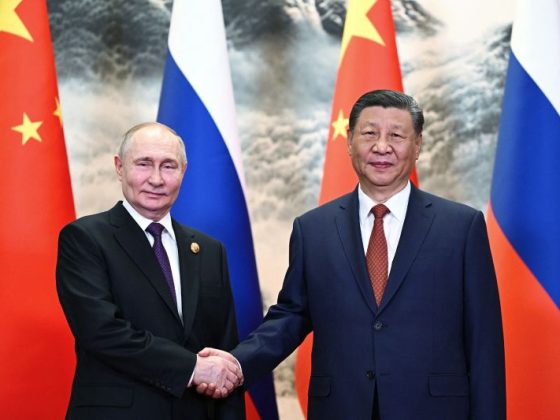
The Israeli military this weekend deployed tanks to the occupied West Bank for the first time in two decades.
In the background of a Gaza ceasefire, Israel has steadily escalated an intense military operation in Palestinian cities in the West Bank, killing dozens and displacing tens of thousands of residents.
Since Hamas’ October 7 attack, Israel has regularly launched airstrikes on the West Bank, which was almost unheard of before. Its defense minister, Israel Katz, said on Sunday that he’d instructed the military to stay for a year and “to prevent the return of residents.”
US President Donald Trump has come under withering criticism for his proposal to expel 2.1 million Palestinians from Gaza. And yet, as the left-leaning Israeli newspaper Haaretz alleged in an editorial Monday, “Israel is already doing in the West Bank what it threatens to do in Gaza.”
Here’s what’s happening.
What is the West Bank?
The West Bank, a territory that lies west of the Jordan River between Israel and Jordan, has been occupied by the Israeli military since 1967. It is home to more than 3.3 million Palestinians.
Israel captured the West Bank and East Jerusalem – including the Old City, with its religious landmarks – from Jordan after a brief war in 1967. Many Israelis believe that Jews have a biblical right to the land, which they call Judea and Samaria.
Since Israel captured the West Bank, around half a million Jewish Israelis have built homes in towns known as “settlements.” Because the West Bank is considered to be occupied under international law, these settlements are illegal, but they are condoned – and even encouraged – by the Israeli government.
In the 1990s, Israel and Palestinian factions started a peace process, which came to be known as the Oslo Accords. The agreement set up a Palestinian government, known as the Palestinian Authority, which would have jurisdiction in parts of the West Bank and Gaza, ahead of the creation of an independent Palestinian state.
Many communities in Palestinian cities are known as refugee camps. Though they now resemble urban neighborhoods, they were established after the 1948 Arab-Israeli war for Palestinians who fled or were forced from their homes during the creation of Israel.
In July, the International Court of Justice, the United Nations’ top court, issued an unprecedented advisory opinion that found Israel’s presence in the West Bank and East Jerusalem to be illegal, and called on Israel to end its decades-long occupation.
What has happened since October 7?
There has always been tension between Palestinians and the Israeli government in the West Bank. Israel has for many years carried out regular incursions into Palestinian communities – targeting, it says, Palestinian militants.
But Hamas’ October 7 attack on Israel ushered in a new era.
The Israeli military ramped up its restrictions on Palestinians, setting up new checkpoints and restricting who could cross from the West Bank into Israel. There was a spike of attacks by Jewish settlers on Palestinians, killing dozens.
Armored Israeli bulldozers often rip up tarmacked roads during these incursions. Israel argues it’s a necessary tactic to unearth improvised explosive devices, but it often leaves whole neighborhoods entirely impassable.
Israel has also targeted other aspects of Palestinian life in the West Bank. The Knesset, the country’s parliament, passed a law last year that would make it extremely difficult for the United Nations’ agency for Palestinians to continue operations, alleging that UNRWA, as it’s known, hasn’t done enough to crack down on extremism in its ranks. UNRWA educates 45,000 Palestinians in the West Bank and provides nearly a million annual patient visits at 43 health care facilities.
What’s happening now?
Israel launched an even more aggressive military operation in the northern West Bank in January, focused on the Jenin refugee camp, dubbed “Operation Iron Wall.” Israel says the operation is necessary to root out Iranian-backed militants who threaten its security.
The defense minister has said that Israel is applying its Gaza playbook to the West Bank.
“A powerful operation to eliminate terrorists and terror infrastructure in the camp, ensuring that terrorism does not return to the camp after the operation is over – the first lesson from the method of repeated raids in Gaza,” Katz said last month.
Israel’s operation has forced more than 40,000 Palestinians from their homes in the West Bank, according to the United Nations. The military has killed more than 1,000 Palestinians in the West Bank and East Jerusalem since October 7, 2023, according to the Palestinian Ministry of Health, which does not distinguish between civilians and combatants. Among those are at least 184 children. Just this weekend, the Israeli military admitted its forces had killed two 13-year-old children, and that it was investigating the incidents.
Israel’s foreign minister, Gideon Saar, told reporters in Brussels on Monday that “it’s military operations taking place there against terrorists and (there are) no other objectives but this one.”
What role does Trump play?
It is impossible to ignore the role of Trump. His election has emboldened those in Israel who want the government to extend full Israeli sovereignty to West Bank settlements, a process known as annexation. Some want to go even further and annex all of the West Bank.
Trump said earlier this month that “people do like the idea” of annexation, “but we haven’t taken a position on it yet.”
“But we’ll be making an announcement probably on that very specific topic over the next four weeks,” he said.
Israel’s far-right finance minister, Bezalel Smotrich, who is in charge of West Bank settlements, ordered preparations for annexation, saying that Trump’s election “brings an important opportunity for the state of Israel.” The only way to remove the “threat” of a Palestinian state, he said, “is to apply Israeli sovereignty over the entire settlements in Judea and Samaria.”
The finance minister seems to play a big role in Netanyahu’s more aggressive approach. Smotrich was against the Gaza ceasefire and is pushing Israeli Prime Minister Benjamin Netanyahu to return to war there. He is a West Bank settler himself. In January, Smotrich said that the government now considers security in the West Bank to be an official “war goal.”
“After Gaza and Lebanon, today, with God’s help, we have begun to change the security concept in Judea and Samaria,” he said.
How did things change this weekend?
Israel’s invasion of Jenin refugee camp was already a significant escalation. But this weekend it became clear that it had no end in sight.
On Friday, Netanyahu visited Jenin and praised the “wonderful job” troops were doing. A photo circulated of him sitting with commanders inside a Palestinian home that the military requisitioned as a command center.
“We are eliminating terrorists, commanders,” he said. “We are doing very, very important work against the desire of Hamas and other terrorist elements to harm us.”
Then on Sunday, the Israel Defense Forces (IDF) deployed a tank platoon to Jenin – the first time tanks have been sent into the West Bank since 2002, during the Second Intifada, or uprising. It’s a sign of just how militarized the operation there has become. The Israeli military no longer believes that ground troops – and even airstrikes – are enough.
And while Trump and Israel’s extremist ministers make plans to expel Gaza’s population, Israel’s defense minister Katz announced that the tens of thousands of Palestinians who have left their West Bank homes in recent weeks will not be allowed to return.
“Today, I instructed the IDF to prepare for an extended presence in the cleared camps for the next year, and not to allow the return of residents and the resurgence of terror,” he said.


